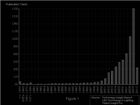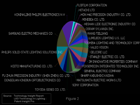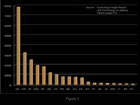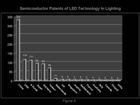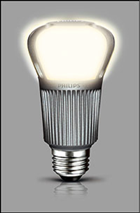LEDs - the Lights of Future
25 May 2010Crystal gazing through patent analysis is beginning to show an intense competition presently going on in the innovation space of lighting with 'light-emitting-diodes (LEDs) An unimaginable array of light devices based on LED are on the anvil. These are touted to be extremely user-friendly and affordable lighting sources in the near future. What it means is simply the death-knell of incandescent light bulb that we are used to living with. The eighteenth century invention of 'light bulb' that literally revolutionised the world and the way we live today, will soon go in oblivion.
In our quest to minimise energy consumption at all levels to save the planet earth from the ills of global warming due to ever increasing green house gas emissions, the compulsion of generating electrical power to keep our houses, shops, offices, streets illuminated at will suddenly appeared too wasteful. Hence began the search for new lighting source. LED is the clear winner and favoured technological option in this game and companies around the world have poured in their financial and technological might in the fray during last decade or so to come up with their portfolio of patented inventions.
Less than two weeks ago1, Royal Philips Electronics unveiled its 12-W EnduraLED light bulb, the industry's first LED replacement for a 60-W incandescent light bulb at the Lightfair International tradeshow in Las Vegas. It is being considered as an important breakthrough in the use of LED lighting technology in so far as it provides an alternative to consumers to switch over from the conventional bulb to the newly invented hi-tech bulb.
The LED industry has been expanding aggressively and there are scores of frontrunner besides Phillips who are creating significant entry barrier for late-comers through patents. Undoubtedly, therefore, strategic alliances are increasing in this area to overcome the patent barrier and to develop technology for commercial use.
What is LED and what can the patent data reveal in this technology area for us? The answer to some of these questions has been provided by a patent analysis study carried out by 'Patent Insight Pro'2.
A light emitting diode (LED) is basically a semi-conductor light source. Like a normal diode, the LED consists of a chip of semiconducting material doped with traces of impurities to create a p-n junction that allows electrons to flow from 'p' end to 'n' end. In this process, electrons move from a higher energy state to a lower energy state and release the balance of energy in the form of a photon. LEDs have, in fact, been known for quite sometime to researchers in solid state physics but few could imagine that this esoteric source of feeble low intensity light could assume the status of a technology that has the potential to drive the global economy and on which the entire civilisation could thrive in future.
The patent analysis study referred above provides some interesting insights that we summarise hereunder:
Using appropriate keywords on LED and its application areas and international classes, a set of 6581 patent families during a sixty year period between 1950 and 2000 were examined. The patent publication trend as observed shows that the real growth of patents in this technology area took from the year 2000 and sky-rocketed thereafter to reach an all time high in the year 2009. The dataset sorted on the 'Assignee Name' gives the list of major players in this technology game as shown in the table below.
| Assignee Name | Total |
| Koninklijke Philips Electronics N V | 135 |
| Samsung Electro Mechanics Co | 128 |
| Philips Solid-State Lighting Solutions Inc. | 80 |
| Koito Manufacturing Co. Ltd. | 55 |
| Fu Zhun Precision Industry (Shen Zhen) Co. Ltd. ..... | 47 |
| Dongguan Kingsun Optoelectronics Co | 37 |
| Toyoda Gosei Co. Ltd. | 36 |
| Sony Corporation | 34 |
| Sharp Habushiki Kaisha | 28 |
Using the powerful features of data manipulation, the report also provides details of key inventors in LED lighting research. But of greater interest is the geographical spread of the patent filing. Figure 3 below shows top eighteen countries with regard to number of patents filed. Clearly, the US, China, Japan, Germany and South Korea are the top five countries leading the research in LED lighting; UK, Australia and Canada are some of the other significant players.
Industrial Applications of LED Technology
Patent classification codes assigned to the patents reveal significant details on the industrial applications of LED technology which have been reported to be as follows:
| Electric Light Sources | Computer Peripheral Equipment |
| Heat Transfer & Control Systems..... | Semi-conductor Technology |
| Traffic Control Systems | Kitchen Appliances |
| Audio Electronics | Scanning Equipment | Medical Devices | Dental Equipment |
| Optics | Automobile Lighting Systems |
| Computer Data Transfer Devices |
Core Technology
Matheo's powerful patent analysis software3 at our command is equally capable of carrying out the studies and analyses as reported by 'Patent Insight Pro'. It was employed to gain further insights in this technology area. It should be recognised that the heart of LED lighting technology and myriads of its applications is the light-source itself with key semi-conductor material having unique composition, dopants and phosphors that would eventually turn the sides to make the technology viable in the commercial world. It is of interest, therefore, to see who are aggressively pursuing semi-conductor research in LED. For this, we fetched the patent data with 'Matheo Patent Software' using keywords associated with semi-conductors arsenide and nitrides of group III elements from EPO worldwide database for the period 2000-2010.
Our view on a closer look at the semi-conductor research in LED lighting gains credibility in view of recent ruling of US District Court4 for the Eastern District of Texas in favour of a Korean Company, Seoul Semiconductor Co. Ltd declaring its US patent (No. 5,075,742) that describes its indium gallium nitride based invention as a fundamental to LED technology. This implies that companies manufacturing or packaging blue, green, white or UV LED devices made from semi-conductor indium gallium nitride as described by this patent can do so only after a licensing agreement with the patent owner. The patent and its family of patents in Japan, Germany, UK and France are stated to be available for licensing from the company to appropriate business partners.
Our quick search, using 'Matheo Patent Software' returned as many as 3413 patents belonging to 1002 patent families. Sorting these on patent classification, it was found that 891 families (~90%) conformed to 'H01L' IPC class signifying semi-conductors used in LED technology. Sorting these further on applicant countries and ignoring a group of patent families from unknown sources, we see the geographic distribution of the sources of these patents families depicting top 17 countries, including India as shown in Figure 4. The results shown here reveal a startling fact hitherto unreported. The earlier studies based on last sixty years data and covering very wide fields of application of LED technology shown above place China and Korea among the top five contenders, but our narrow investigation vide Figure 4 here on key aspects of technology on recent patent data clearly puts China way ahead of other top contenders, viz., US, Korea and Japan. In fact, South Korea also does not appear to be too behind the US. The court decision in favour of Seoul Semiconductor Co. as mentioned above duly supports our finding and conclusion.
It does not seem too far away when we would actually see which country or companies claim their supremacy in this technology race. But it is clear that our life styles are going to change for ever with our houses and offices being lit by a wide range of cool, cosy, colourful and affordable lighting sources.
References
1. http://www.photonics.com/Article.aspx?AID=42190
2. Gridlogics Technology Insight Report - LEDs in Lighting.pdf
3. http://www.matheo-patent.com/
4. http://www.photonics.com/Article.aspx?AID=37280
